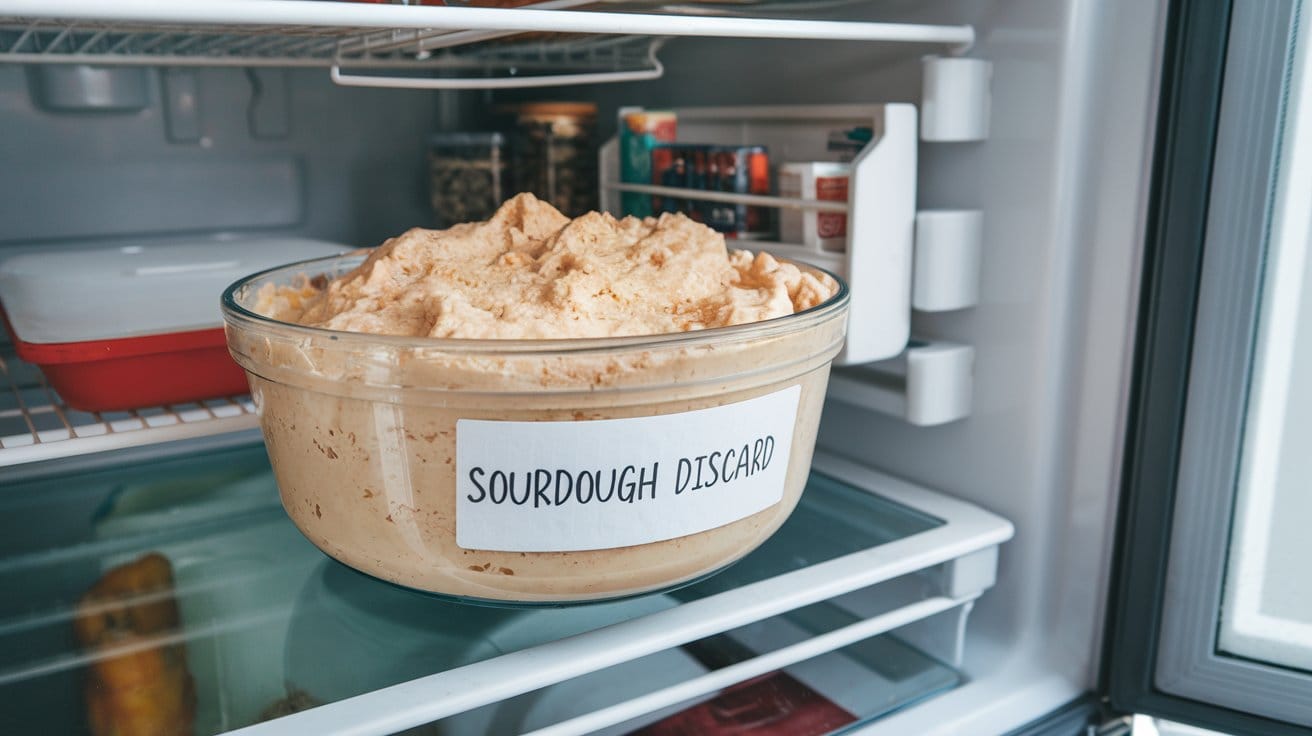How long does sourdough discard last in the fridge? If you’re a sourdough baker, you’ve likely encountered this byproduct of feeding your starter. Sourdough discard is the portion removed to maintain balance and prevent overgrowth. While often mistaken for waste, it’s a versatile ingredient with countless culinary applications. From adding a tangy twist to pancakes and crackers to enhancing muffins and cookies, sourdough discard offers endless possibilities.
However, the value of sourdough discard goes beyond its taste. Proper storage is critical for maintaining its quality and extending its usability. Without correct handling, discard can spoil quickly, leading to waste and missed opportunities for creative cooking. Understanding the factors that impact its shelf life is the first step in ensuring that your sourdough discard remains a reliable addition to your kitchen.
What is Sourdough Discard?
Sourdough discard is the leftover starter removed during regular feedings. Unlike active starter, which is bubbling with life and ready to make bread rise, discard is considered dormant and unsuitable for leavening. Learn more about the difference between sourdough starter and discard. However, its slightly tangy flavor and nutrient content make it an excellent ingredient in recipes where rising power isn’t needed.
Common Uses in Recipes
- Pancakes and waffles: Adds a sourdough tang to breakfast classics..
- Crackers: Creates a crisp, flavorful snack.
- Quick breads and muffins: Enhances texture and depth of flavor, as suggested in these creative sourdough discard recipes.
- Cookies and brownies: Brings a subtle sourdough essence.
Nutritional and Flavor Profile
Sourdough discard retains the same nutritional benefits as the starter, including probiotics (if used fresh) and the complex flavor notes that come from fermentation. Its acidity makes it an excellent flavor enhancer, especially in recipes that benefit from a subtle tang.
By incorporating discard into your recipes, you’re not only reducing waste but also adding a unique, artisanal touch to your cooking.
Factors Affecting Sourdough Discard Longevity in the Fridge
1. Temperature Consistency
Refrigeration slows down fermentation and bacterial growth, but discard still requires a consistently cool environment. Fluctuations in fridge temperature can encourage spoilage, so ensure your refrigerator stays around 37°F (3°C).
2. Starter Hydration Levels
The hydration level of your sourdough starter directly affects the longevity of discard. A wetter (higher hydration) starter may spoil faster due to its increased water activity, which provides a breeding ground for mold and bacteria.
3. Flour Type
Whole grain flours, such as rye or whole wheat, contain natural oils that can turn rancid over time, shortening the shelf life of discard (how long sourdough discard lasts). White flour-based discard typically lasts longer in the fridge due to its lower oil content.
4. Proper Sealing and Containment
Airtight containers are essential for preserving discard. Exposure to air can cause the surface to dry out, leading to crust formation. Worse, it increases the risk of contamination by airborne bacteria or mold spores. Use a clean, tightly sealed container to ensure your discard stays fresh for as long as possible.
By understanding and addressing these factors, you can significantly extend the shelf life of your sourdough discard, ensuring it’s always ready for your next culinary creation.
How Long Does Sourdough Discard Typically Last in the Fridge?
Sourdough discard is a versatile ingredient, but its shelf life depends on how it’s stored and the conditions it’s kept in. Generally, fresh sourdough discard can last up to 2 weeks in the fridge, provided it is stored correctly (storage tips for sourdough discard). The discard is at its best within the first 7–10 days, retaining its flavor and texture. After this period, it can begin to degrade.
Fresh Discard vs. Older Discard
- Fresh discard: Ideal for most recipes due to its mild tang and smooth texture.
- Older discard: May develop a stronger tangy flavor, which can be desirable for certain recipes like crackers but less suitable for delicate baked goods.
Signs That Discard Has Gone Bad
To ensure safety, inspect your sourdough discard before use. Look for the following indicators:
- Smell: While a tangy or sour aroma is normal, an unpleasant, rancid, or off-putting smell is a sign it has spoiled (risks of using expired discard).
- Mold or discoloration: Visible mold, black or pink spots, or unusual discoloration means the discard should be discarded immediately.
- Texture changes: Slimy or overly dry discard is a clear indication that it’s past its prime.
When in doubt, it’s better to err on the side of caution and discard any questionable sourdough discard. Using spoiled discard can affect the taste and safety of your recipes.
How to Make Sourdough Discard Last Longer
Extending the shelf life of sourdough discard is possible with proper storage and preservation methods. Here’s how you can maximize its usability:
Best Practices for Storing Discard in the Fridge
- Use a clean, airtight container to prevent contamination and reduce exposure to air, which can dry out the discard.
- Label the container with the date to track how long it’s been stored.
- Store it on a fridge shelf rather than in the door, where temperature fluctuations are common.
Tips for Freezing Sourdough Discard
Freezing is an excellent way to extend the discard’s life indefinitely:
- Divide discard into small portions (e.g., using ice cube trays) for easy thawing, as suggested in these sourdough discard freezing tips.
- Freeze it in airtight, freezer-safe bags or containers.
- Thaw frozen discard in the fridge overnight before using it in recipes.
Adding Salt or Sugar for Preservation
Incorporating a small amount of salt or sugar into the discard can help inhibit bacterial growth:
- Salt: Acts as a natural preservative, especially for recipes like crackers or savory baked goods.
- Sugar: Balances the tanginess and aids in preservation, making it ideal for sweet recipes.
By implementing these techniques, you can ensure that your sourdough discard remains fresh, flavorful, and ready to use, no matter how long you choose to store it.
How to Use Sourdough Discard Before It Goes Bad
Sourdough discard is a versatile ingredient, and using it before it spoils ensures no waste while adding a unique tang to your favorite recipes. Even older discard, which may be too sour for some baked goods, is perfect for specific recipes.
Recipes Suitable for Older Discard
- Crackers
- Sourdough discard’s tangy flavor complements homemade crackers. Combine it with herbs, spices, and olive oil for a crunchy snack.
- Pizza Dough
- Older discard adds complexity to pizza dough. Mix it with flour, water, and yeast for a dough with depth and character.
- Quick breads:
- Incorporate discard into quick breads like banana bread or zucchini bread for a subtle sourdough essence.
- Pancakes and Waffles
- Older discard’s acidity shines in breakfast recipes, creating fluffy pancakes or waffles with a slight tang.
Using discard in these recipes not only reduces waste but also enhances your dishes with unique flavors that store-bought ingredients can’t replicate.
Risks of Using Expired Sourdough Discard
While it may be tempting to use discard that’s been sitting in the fridge too long, it’s important to understand the potential risks:
Health Risks
- Spoiled discard can harbor harmful bacteria or mold, which can cause foodborne illnesses if consumed (why discard should be thrown out when spoiled).
- Visual signs like mold or discoloration indicate discard is no longer safe to use.
Negative Effects on Taste and Texture
- Expired discard may introduce unpleasant, overly sour, or rancid flavors to your dishes.
- Its texture can become slimy or overly dry, impacting recipe outcomes.
When in doubt, discard anything questionable to avoid compromising your health or recipes.
Alternative Ways to Store Sourdough Discard
Proper storage is key to extending the life of sourdough discard. While refrigeration is common, other methods can keep your discard usable for longer.
Storing at Room Temperature for Short-Term Use
- Sourdough discard can be kept at room temperature for 1–2 days if you plan to use it soon.
- Ensure it’s stored in a clean, airtight container to prevent contamination.
Freezing for Long-Term Use
- Freezing is the most effective way to preserve discard for months, as highlighted in these freezing tips for sourdough discard:
- Portion discard into small amounts to thaw as needed.
- Label the containers or bags with the freezing date.
Drying Discard for Indefinite Storage
- Spread discard thinly on parchment paper and allow it to dry completely, similar to the method suggested in long-term sourdough discard preservation.
- Once dried, break it into flakes and store in an airtight container.
- Rehydrate the dried discard by mixing it with water for future use in recipes.
By exploring these alternative storage methods, you can ensure that no sourdough discard goes to waste, keeping it ready for your next culinary adventure.
FAQs on Sourdough Discard
How Can I Tell if Sourdough Discard is Bad?
To determine if sourdough discard is still safe to use, look for these signs:
- Smell: A tangy or slightly sour aroma is normal, but a foul or rancid odor indicates spoilage.
- Appearance: Mold, black or pink discoloration, or crusty, dry patches are clear indicators it’s no longer safe.
- Texture: Slimy or overly dry discard is a sign it’s past its prime.
When in doubt, it’s always safer to discard questionable sourdough discard.
Can You Freeze Sourdough Discard?
Yes! Learn more about freezing sourdough discard effectively to extend its life indefinitely when properly stored. Here’s how to do it:
- Portion discard into small amounts (e.g., ice cube trays or freezer-safe bags).
- Label each container with the freezing date for easy tracking.
- Thaw discard overnight in the refrigerator before using.
Freezing is a great option for those who bake occasionally or want to preserve larger amounts of discard for future recipes.
What Happens if You Use Discard Past Its Prime?
Using expired sourdough discard can lead to:
- Unpleasant flavors: Overly sour or rancid notes that overpower the dish. For safety, review these risks of using expired sourdough discard.
- Texture issues: Slimy discard can affect the consistency of your recipes.
- Health risks: If mold or bacteria are present, there’s a risk of foodborne illness.
Avoid using discard that shows any signs of spoilage.
How Do I Revive Frozen or Dried Discard for Recipes?
- Frozen discard: Let it thaw overnight in the fridge, then stir to recombine any separated liquid, following these thawing tips for sourdough discard.
- Dried discard: Rehydrate by mixing equal parts dried discard and warm water. Let it sit for a few hours until the consistency returns to normal.
These methods ensure your preserved discard is ready to enhance your next recipe.
Conclusion and Best Practices
Sourdough discard is a valuable and versatile ingredient, but its usability depends on proper storage and handling. In the fridge, discard can last up to two weeks, while freezing or drying extends its life significantly.
To make the most of sourdough discard:
- Check quality regularly: Look for signs of spoilage before using.
- Store properly: Use airtight containers and consider freezing or drying for long-term storage.
- Get creative: Explore a variety of recipes, from pancakes to crackers, to use discard sustainably.
By incorporating these best practices into your routine, you’ll not only reduce waste but also enjoy the unique flavors and textures that sourdough discard brings to your kitchen creations. Stay mindful of quality, and your discard will be a reliable culinary asset.










